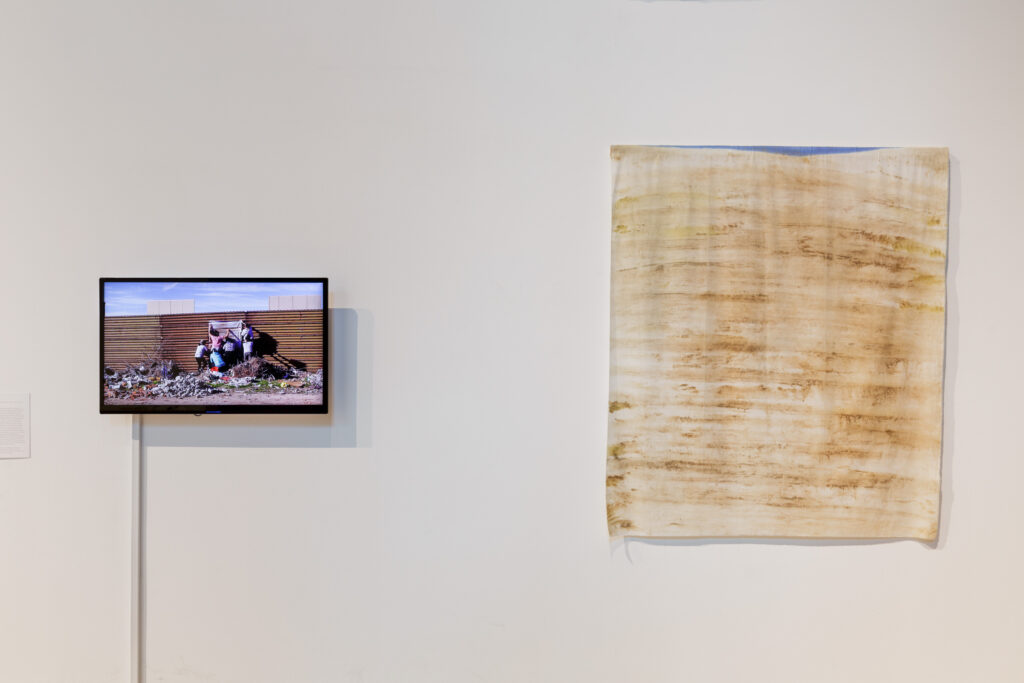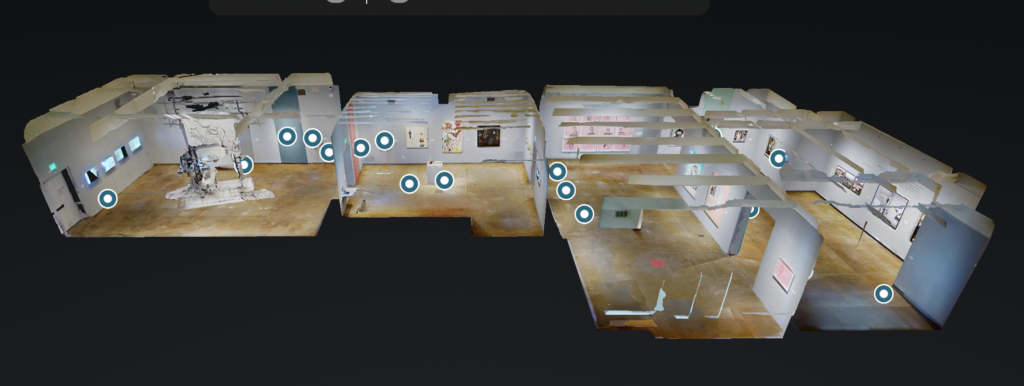Building on the idea of a hybrid curatorial model discussed in the previous blog post, this entry will further develop the concept of digital exhibitions in light of the Week 8 class content.
In Curating the Moving Image, Mark Nash argues that images are no longer merely media, but a space of post-medium practice—allowing artists and curators to move across film, installation, interaction, and performance, thereby expanding the question of how to curate time.
In my exhibition concept, this self-structuring temporality is extended through the digital platform. I aim to create a shift in perception, a re-narrative mechanism for squeezed, obscured, and fragmented time.
“Digital Intimacy” in Real-Time Participation
Interactive live streaming is a technique that facilitates real-time participation. I was particularly inspired by Tanya Aguiñiga’s Borderlands project, where she synchronized live actions with online interactions to create a sense of “remote presence.”

Tanya Aguiñiga: Borderlands Within/La Frontera Adentro
This resonates with the “Lemon Experiment” that Marcus demonstrated in class. If Aguiñiga’s live broadcast installation activates synchronous participation through action, then the Lemon Light and Shadow Experiment invites us to reconsider non-linear time at the level of perception. One emphasizes connectivity, the other perception—together, they expand my curatorial imagination of time as a medium in itself.

Spatial Translation of Immersive Time Experience
Augmented reality (AR) and virtual reality (VR) elements are integrated into physical exhibitions, not only preserving their digital afterlife but also creating a spatial memory that can be revisited.
For example, the USC Pacific Asia Museum’s virtual reconstruction project We Are Here: Contemporary Art and Asian Voices in L.A. uses Matterport scanning technology to create a virtual exhibition space, allowing users around the world to navigate it as if walking through it in person.

We Are Here: Contemporary Art and Asian Voices in Los Angeles
Summary:
“Spatial narrative replaces written narrative—the activation of the spectator within a three-dimensional volume.”
— Christine van Assche, Saving the Image, 2003
While the exhibition follows a thematic progression—from oppression to awakening to resistance—the spatial structure adopts a non-linear design, informed by Marcus’s notion of the co-construction of space, time, and perception. This allows audiences from diverse backgrounds to enter the exhibition through points most relevant to their own experiences. Time may be structurally coercive, but the path of experience should remain individualized and diverse.
Reference:
armoryarts. (n.d.). Tanya Aguiñiga: Borderlands Within/La Frontera Adentro. Flickr. https://www.flickr.com/photos/armoryarts/albums/72157713522326388/
Tanya Aguiñiga: Borderlands Within/La Frontera Adentro. (2020). Armoryarts.org. https://www.armoryarts.org/exhibitions/2020/borderlands
We Are Here: Contemporary Art and Asian Voices in Los Angeles – Pacific Asia Museum. (2024, August 8). Pacific Asia Museum. https://pacificasiamuseum.usc.edu/exhibitions/we-are-here-contemporary-art-and-asian-voices-in-los-angeles/


23 March 2025 at 22:43
Xinyao Tong’s peer review
1. Advantages
A. Flexible use of theories and literature: Compared with my project, I think your project and blogs use a lot of literature, papers and exhibitions in related fields. For example, when discussing the context of ‘time exploitation’ you cite Time magazine’s ‘The Secret Tax on Women’s Time’, which mentions that the extra burden of time that women take on at home and in the workplace is often overlooked. These theoretical perspectives help you to look at the issue of ‘time poverty’ at a structural level, rather than at the surface of the phenomenon.
B. Critical Thinking and Reflective Consciousness: I strongly agree with your reflection on your own project and the ethics of curation through the samples of exhibitions and documents you have searched. One of the points that resonate with me the most is when you quote curatorial theorist Claire Bishop in Artificial Hells, reminding yourself not to over-emotionalise at the expense of critical thinking on the audience. I think this is very important, just as I need to think about this when the subject matter of my current project involves real suffering and hardship.
2. Suggestions
A. Implementation of artworks and site of the exhibition
While the wealth of theoretical literature is a strength, it is also a drawback of your blog. Too much literature resultes in me can’t get a very clear plan of your project. You tell a lot about your inspirations through art cases, but you don’t clearly identify the location of your project, and the specific artworks.
In today’s collective meeting you also showed us your preferred choice of location. Basically, they are all in Asia. I would suggest that you don’t choose locations where you can’t get a specific map or a specific room. Because you can’t plan further on the display of the exhibition without this information.
I’ll put some location recommendations in the resource summary at the end of the review.
B. Enhancement of interaction with the audience
Through your blog I learn that you still want your exhibition to be interactive and mentioned the means of online exhibition. This reminds me of the ‘dream archive’ that I have planned for my project. I think you could also consider introducing more digital interactive tools. For example, the online platform of the exhibition could include a participation channel, inviting the audience to share their own stories of ‘lost time’ in their daily lives as women.
At the same time, there are several experiences that can be borrowed and use. One example is ‘Before I Die’ by American artist Candy Chang. The project set up a blackboard and asked people to fill in ‘Before I die, I want …’, thus inviting the public to think about their life wishes [1]. You could also set up a similar interactive area, such as ‘If I had more time, I’d like to…’, to encourage the audience to write about activities they would like to devote their time to but can’t because of practical responsibilities.
C. Expanding the Scope and Cases of Artists
I find that currently your theories and cases are mostly from western contexts, and I think you need more cases from East Asian female artists. For example, Xiao Liu’s work ‘Mei Mei’ in the 2024 Central Academy of Fine Arts undergraduate graduation exhibition shows such an artwork of a Chinese woman who gradually lost her original name during her time as a mother [2]. This will help the viewer to fully understand ‘Asian Women’s Time Poverty’.
Resources
[1] Candy Chang. (n.d.) Before I Die. Available at: https://www.candychang.com/beforeidie/ (Accessed: 23 March 2025)
[2] CAFA Art Museum. (2024) 2024 Central Academy of Fine Arts Undergraduate Graduation Exhibition. Available at: https://www.cafamuseum.org/exhibit/newsdetail/3470 (Accessed: 23 March 2025).
Site recommendations
[1] Mimosa House. (n.d.) Mimosa House – A non-profit curatorial platform for collaborative and experimental practices. Available at: https://www.mimosahouse.co.uk (Accessed: 23 March 2025).
[2] Asia Art Archive. (2012) A Report on the Times Museum, Guangzhou, China. Available at: https://www.aaa-a.org/programs/a-report-on-the-times-museum-guangzhou-china (Accessed: 23 March 2025).
[3] I: Project Space. (n.d.) Independent art space and residency in Beijing. Available at: https://yi-projectspace.org (Accessed: 23 March 2025).